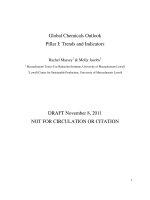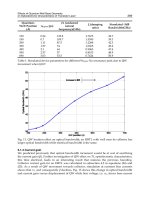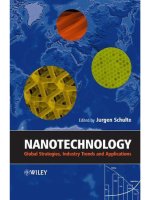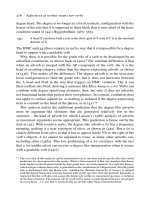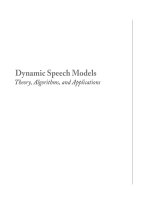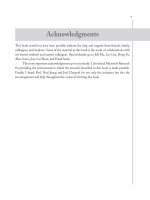Nanotechnology Global Strategies, Industry Trends and Applications phần 8 pot
Bạn đang xem bản rút gọn của tài liệu. Xem và tải ngay bản đầy đủ của tài liệu tại đây (317.78 KB, 20 trang )
For better or worse, venture capitalists need to acknowledge that they have
leadership responsibilities to society at large. The power of the capital formation is
one aspect. The power of the intellectual capital formation is even greater.
6.6 Summary
Life is definitely more complicated than ever before, regardless of what aspect we
look at. Business is more challenging; there are more dimensions, more factors to
consider, more unknowns that need to be addressed. More knowledge is required;
more people of diverse backgrounds need to participate in the creatio n of value.
Question: How is market value created out of innovation?
Answer: To direct and manage this process, an effective approach is to use of
selected human resource teams.
The teams will include multiple points of view from a cross section of human
society, to assess common needs and expectations. Representatives from the
following areas are encouraged to participate actively in the process:
Public relations people deal with issues of visibility, credibility and desirability.
Creative translators can translate innovation to different venues or contexts.
Business people can only mak e money when people or customers acknowledge
some benefit to them. Their commitment to buy determines value.
Legal experts protect the intrinsic value of the innovation.
Government agencies may regulate or promote certain kinds of innovation.
The successful articulation and communication of a business concept that integrates
all of these points of view will be the basis of a humanistic approach to building a
business with true long-term value.
Need for a New Type of Venture Capital 125
Part Three
Frontiers of
Nanotechnology
7
Frontier Nanotechnology for
the Next Generation
Tsuneo Nakahara and Takahiro Imai
Sumitomo Electric Industries Ltd
This chapter proposes how to select unique research targets of frontier nanotech-
nology fields by considering the small size effect and the nano size effect. Examples
are given for each size effect.
At the Asia-Pacific Nanotech Forum held in Tsukuba, Japan, in February 2002
more than ten policymakers from various industrialized countries delivered
speeches about national strategy together with budgetary plans for frontier nano-
technology. In particular, speakers from newly industrialized countries in Asia
strongly insisted that they would put the greatest emphasis on nanotechnology and
increase their budget rapidly as much as possible. And they said they were quite
sure they would catch up the US and Japan by the time of mass-produced
nanotechnology products, as they did in the semiconductor and electronics
industries.
All the policymakers said that they planned a large budget for research and
development on frontier nanotechnology for several years starting in 2001. Almost
all of their budgets were allocated to very similar projects previously proposed
by Japan and the US, such as nanocarbon materials, nanoelectronics and nanobio-
materials. Consequently, there will be a fear that too many budgets for very
similar projects will create a nanotechnology bubble that will eventually burst. It
is strongly recommende d that they adopt different approaches from each other so
Nanotechnology: Global Strategies, Industry Trends and Applications Edited by J. Schulte
# 2005 John Wiley & Sons, Ltd ISBN: 0-470-85400-6 (HB)
that they may be able to reach unique and complementary achievements in frontier
nanotechnology.
How can we select unique and original research themes in the field of frontier
nanotechnology? We need to consider the original target of the nanotechnology.
7.1 What is the Target of Nanotechnology?
Figure 7.1 illustrates a beneficial way of selecting innovative themes in frontier
nanotechnology. The left-hand graph shows resistivity change of various wires as a
function of temperature. The resistivity of ordinary metallic wire such as copper
wire decreases linearly as temperature goes down. The resistivity of cryogenic wire
such as highly purified aluminium wire exhibits a step change at a specific low
temperature but never becomes zero, even at 0 K. Notice that the resistivity of
superconductor wire decreases as temperature goes down and abruptly becomes
zero at a certain low temperature, T
C
, called the Curie temperature.
The right-hand graph illustrates change in a certain physical parameter as a
function of size, assuming that the phenomenon is similar to change in resistivity as
a function of temper ature. With ordinary mater ials the parameter may change
linearly as size becomes small. With some extraordinary materials the parameter
may exhibit a step change at a certain small size as in the cryogenic wire. Let us call
this the small size effect. Notice that with some revolutionary materials the para-
meter may change surprisingly at a certain critical nanosize, as in the superconductor
wire. Let us call this the nano size effect.
Figure 7.2 shows an example of the small size effect. This is the case of
compressed ferrous alloy powder developed by Sumitomo Electric in 2001. The
compressed alloy powder shaped like a coin shows high electromagnetic wave
absorption in the microwave frequency region this is due to reso nance. By gluing
Temperature (K)
Resistivity
0
Ordinary wire
ex. Cu
Superconductive
Wire ex. Bi system
TC
Cryogenic wire
ex. pure Al
Size
Parameter
Ordinary
Extraordinary
Small size effect
Critical size
Revolutionary
Nano size effect
Figure 7.1 What is the target of nanotechnology?
130 Nanotechnology
these coins together, excellent performance has been obtained for thin and large-
area electromagnetic wave absorbing sheets. These electromagnetic wave absorbing
sheets are especially suitable for small and precise communication and for
electronic equipment such as cellphones and personal computers.
Figure 7.3 shows carbon allotropes to explain an example of the nano size effect.
Note the significant difference between a single crystal such as a diamond and a
Feature
Feature
Particle shape is controlled at the nano-level,
giving high magnetic absorption characteristics
Adjustable particle shape and metal
composition giving optimized absorption peak
from 0.5 to 5 GHz
Application
Application
Cell phones
Game consoles
BS/CS converters
VTRs digital cameras
Personal computers
Electromagnetic waves absorber
Compressed ferrous alloy powder
Feature
Feature
Feature
Feature
Application
Application
Application
Application
Figure 7.2 An example of the small size effect
Graphite
Graphite
Fullerene
Fullerene
Diamond
Diamond
Merit:
Hardness,
Thermal conductivity,
Chemical inertness,
Wide band gap
semiconductor,
Transparent,
Low dielectricity
Demerit:
Hard to machine,
Small Size,
Expensive
Laser machining,
High speed growth,
Film deposition,
Dry etching
Overcome
Eco-material
Eco-material
Varied Chemical Bond
Varied Chemical Bond
Graphite
Graphite
Fullerene
Fullerene
Diamond
Diamond
Graphite
Graphite
Fullerene
Fullerene
Diamond
Diamond
Graphite
Graphite
Nanotube
Fullerene
Fullerene
Diamond
Diamond
Carbyne
Merit
Hardness
Thermal conductivity
Chemical inertness
Wide band gap
semiconductor
Transparent
Low dielectric constant
Demerit
Hard to machine
Small size
Expensive
Laser machining
High speed growth
Film deposition
Dry etching
Overcome
Eco-material
Eco-material
Varied Chemical Bond
Varied Chemical Bond Self-constructed
nanostructure
Eco-material
Eco-material
Varied Chemical Bond
Varied chemical bond
Figure 7.3 An example of the nano size effect
Frontier Nanotechnology for the Next Generation 131
uniform cluster molecule such as a fullerene. Fullerenes are characterized by their
atomically uniform size, autonomous formation for synthesis and quantum effective
functions. Diamond is entirely different. A detailed explanation will be given below.
7.2 Diamond Nanotechnology Is a Good Illustration
Diamond has many excellent prope rties as a semiconductor and it can be precisely
machined into a nanostructure. Diamond is not a substantially self-structured nano-
material, unlike fullerene so. Nevertheless, there are three reasons why diamond can
be considered as one of the best nanomaterials. The first is its rigid atomic structure
that gives diamond an extremely high hardness, very high thermal conductivity and
high acoustic velocity. The second is its properties as a semiconductor, which
suggest applications for semiconduct or devices, optical devices and electron emis-
sion devices. The third is the recent advanced developments in diamond fabrication
and synthesis technology.
One of the most outstanding advantages of diamond as a nanomaterial is that
it can be manufactured very precisely in a controlled manner. This is particularly
important during precision industrial mass production such as for nanoelectronics.
Sometimes the precision of products made from self-structured material like fuller-
enes and carbon nanotubes is very sensitive to the conditions in the manufacturing
environment, just as with agricultural products.
Diamond has many distinctive properties as a semiconductor and can be extremely
precisely machined on a nanometre scale compared with other materials. Even now,
Figure 7.4 A diamond nanoemitter of size 2 nm
132 Nanotechnology
machined nanoscale diamond is at least comparable to self-structured nanomaterials
such as carbon nanotubes. Figure 7.4 shows a photograph of nanostructured dia-
mond. This is a steeple diamond single crystal made by reactive ion etching using
patterned aluminium sacrificial masks. The aluminium mask disappears aft er pre-
cisely guiding the position of the steeple on the diamond surface.
The radius is 2 nm at the top of the steeple in Figure 7.4. This is nearly equal to
the radius of a carbon nanotube. The size 2 nm can be consider ed as one of the most
advanced examples of top-down nanotechnology. Figure 7.5 shows the measured
electron emission from the diamond tips made by this method as compared with
tips made from flat diamond. It is surprising that the electron emission from the tips
was increased by almost 1 million times at the applied electric field of 1.0 V/mmas
compared with that from the flat diamond surface. This can be called the nano size
effect.
Many years ago the triode vacuum tube was developed and was used industrially
for a long time. Then it was necessar y to prepare very high temperatures of over
2000
C in order to get electron emission from the cathode of the triode vacuum
tube. Therefore the size of the triode vacuum tube was of order several centimetres.
Because of its large size and its poor reliability, due to the high temperature, it
was replaced by solid-state semiconductors in many places. Now, with this
diamond nanoemitter, the required temperature for reasonable electron emission
becomes 30
C, which is almost room temperature. The size of the triode vacuum
tube can be squeezed down to a few micrometres. Figure 7.6 shows a design
example of such a micro vacuum triode. Let us call this a vacuum microelectronic
device (VMD).
10
–12
10
–11
10
–10
10
–9
10
–8
10
–7
10
–6
10
–5
10
–4
Current (A)
Without tip
Emission
Current
With tips
Electric field (V/µm)
0 1.0 2.0
Figure 7.5 Electron emission characteristics
Frontier Nanotechnology for the Next Generation 133
Figure 7.7 shows estimated potential properties of the VMD as compared with
other conventional semiconductor devices. Because the electrons in the VMD travel
in the vacuum space, their mobility and their velocity will be much larger than in
any other semiconductor materials. Therefore the frequency limit for the VMD will
be much higher than for the other semiconductor devices, as shown in Figure 7.7.
Also, performance of the VMD under a high-power applied environment is
expected to be excellent because of the nature of diamond.
The diamond nanoemitter explained above was one result of work undertaken by
Sumitomo Electric Industry, Ltd and its partners under the auspices of METI and
NEDO in Japan. The project extended from this work is now a new Japanese
national project that was begun in fiscal year 2003 by METI and NEDO.
Anode
Gate
e
e
Centimetres
Micrometres
Advantage are
high speed and
high breakdown
voltage
e
e
e
e
e
e
Micrometres
Vacuum tube
e
e
e
e
VMD
Using diamond we
can achieve
smaller size and power Loss
Emitter
Hot cathode
Figure 7.6 Schematic diagram of a vacuum microdevice
Longer transmission
distance
InP
SiC
Si
Larger information
GaN
SiC
Si
Diamond emitter
(Vac. . Device)
Power
Controlled
Device
Base Station
Satellite
Station
GaAs
InP
Average power (W)
SiC
Si
10
9
10
10
10
11
10
12
SiC
Si
Diamond emitter
(VMD)
Power
controlled
device
Base station
Satellite
Station
Frequency (Hz)
DC
GaN
10
−1
10
1
10
5
10
3
GaAs
Wireless network
Figure 7.7 Potential functions of semiconductor and vacuum device
134 Nanotechnology
7.3 Conclusion
In the field of frontier nanotechnology, there will be a tremendous number of
opportunities for selecting research and development programmes from top down to
bottom up. Also, there will be a considerable variety of research and development
fields classified by various materials, structures and processes. Among these frontier
nanotechnology projects, projects on the nano size effect discussed here will be
most effective in creating the next generation of industry. A diamond nanoemitter
project was explained as an example.
If huge sums of money are invested in very similar projects worldwide, there will
be fear that a bubble may be created and then collapse, as happened a few years ago
with information technology. It is recommended that each research institute and
each industry around the world should make an independent plan for the frontier
nanotechnology with their own unique programmes and perform researc h and
development work aimed at original achievements in order to avoid duplication.
When, in the near future, these achievements are integrated worldwide, the next-
generation industries will be created more efficiently.
Frontier Nanotechnology for the Next Generation 135
8
Next-Generation Applications
for Polymeric Nanofibres
Teik-Cheng Lim and Seeram Ramakrishna
Nanoscience and Nanotechnology Initiative, National University of Singapore
8.1 Background
Polymeric fibres that possess a high degree of molecular orientation along the fibre
longitudinal axis can be formed from a solution or melt of the polymer via various
techniques that involve a number of molecular processes. These processes involve
time- and temperature-dependent molecular motions, phase transitions under high
stress, entanglement constraints and various intermolecular reactions. As a result,
the final state of molecular order in a fibre depends on the process variables. These
variables are stress, strain, time-dependent temperature and the length distribution
of the molecules. These polymer microfibres (of diameter in the range $1–100 mm)
can be obtained usin g spinning or drawing techniques.
Investigation into the structure of polymeric microfibres has brought about the
ability to manipulate structural formation, that has resulted in fibres of high tensile
modulus and tensile strength. These high-strength high-m odulus fibres are used in
producing ropes, satellite tethers and high-performance sails and in polymer
composites for applications such as aircraft, boats, automobiles, sporting goods
and biomedical implants. In addition, a number of remarkable fibre properties
include UV resistance, electrical conductivity and biodegradability. This ability to
engineer properties of microfibres to meet specific requirements has resulted in
Nanotechnology: Global Strategies, Industry Trends and Applications Edited by J. Schulte
# 2005 John Wiley & Sons, Ltd ISBN: 0-470-85400-6 (HB)
demands from the industry for production of nanodiameter fibres with desired
features. Structured polymeric fibres with diameters in the submicron range are of
considerable interest in a variety of applications. Figure 8.1 gives a systematic view
of micro-, submicron- and nanoscale fibre diameters in comparison to a typical
adult height. The importance of decreasing fibre diameter can be gauged from
the percentage utilization of microfibre in total fibre consumption, as shown in
Figure 8.2.
The reduction of the fibre diameter to the nanometre scale (about 10
À3
to
10
À1
mm) results in a number of superior properties such as increase in surface-to-
Figure 8.1 Relative diameter of micro- and nanofibres to other objects (in logarithmic
scale)
Figure 8.2 Utilization of microfibre as a percentage of total fibre consumption in the
United States. Data condensed from A Short History of Microfiber, The Andromedan Design
Company, 1998, www.googalies.com/microfsa.html
138 Nanotechnology
volume ratio (Figure 8.3), decrease in pore size, a drop in structural defects, and
enhanced physical behaviour. Consequently, nanofibres are excellent candidates for
application in tissue engineering, high-performance filtration, chemical-biological
protective clothing and polymer composite reinforcement. With the relative
application of microfibre approaching its saturation point in the 1970s and 1980s,
Figure 8.3 There is a sharp increase of surface area per unit volume with decreasing fibre
diameter
Figure 8.4 Annual number of scientific publications on polymeric nanofibres. Data
obtained from Institute of Scientific Information (ISI) based on these four terms: polymer,
polymeric, nanofiber, nanofibre
Next-Generation Applications for Polymeric Nanofibres 139
we may expect the rise of nanofibre applica tion in the 2000s in a similar fashion to
microfibre during the period 1940 to 1960.
Polymeric nanofibres have undergone a surge in development over the past
decade. This can be demonstrated by the number of publications shown in
Figure 8.4. As the research results of today may lead to commercial products of
tomorrow, we take an overview of present research and development of polymeric
nanofibres as a glimpse of next-generation applications.
8.2 Biomedical Applications
8.2.1 Medical Prostheses
Several US patents that describe techniques for making vascular prostheses [1–6]
and breast prostheses [7] refer to the use of polymer nanofibres. Recently, protein
nanofibres were deposited as a thin porous film onto a prosthetic device for
implantation in the central nervous system [8–11]. The film with a gradient fibrous
structure was expected to efficiently reduce the stiffness mismatch, hence the stress
concentration, at the tissue/device interface, thereby preventing the fracture or
fatigue failure of the device after implantation.
8.2.2 Tissue Engineering Scaffolds
Naturally occurring materials such as silk, keratin, collagen, viral spike protein,
tubulin and actin (proteins), cellulose and chitin (polysaccharides) and mucin (a
glycoprotein) are characterized by well-organized hierarchical fibrous structures
ranging from nanometre to millimetre scale. Therefore materials for application in
tissue engineering should be biocompatible with, and mimic, the native tissue
structure in order to fulfil its biological functions. The challenge is to design three-
dimensional scaffolds of synthetic biodegradable matrices that provide temporary
templates for cell seeding, invasion, proliferation and differentiation, thereby
resulting in regeneration of biologically functional tissue [12]. Biodegradable
scaffolds from nanoscale polymeric fibres may hold the key in adjusting the
degradation rate of a specified biomaterial in vivo. This may well be inferred
from the work of Migliaresi and Fambri [13] that reveals the effect of microfibre
size on degradation delay and related properties.
Due to the fact that cells gather and attach around fibres with smaller diameter
than themselves [14], attempts have been made to convert either synthetic polymers
or naturally derived materials into small nanofibres and nanofibrous struct ured
scaffolds to mimic the morphological characteristics of native fibres [15–21]. It has
been shown recently that smooth muscle cells oriented themselves along aligned
nanofibres [22, 23] thereby suggesting a mode of anisotropic tissue growth, as
shown in Figures 8.5 and 8.6.
140 Nanotechnology
8.2.3 Drug Delivery
Drug delivery in the most physiologically acceptable manner has always been an
important concern in medicine, and nanofibres have been demonstrated to exhibit
promising potential in this area. Drug delivery via polymeric nanofibres is based on
the principle that the dissolution rate of a particulate drug increases with increasing
surface area of both the drug and the corresponding carr ier if needed. Recent
Figure 8.5 Smooth muscle cells attached and grew along the alignment of the copolymer
P(LLA/CL) 75:25 nanofibre
Figure 8.6 Neurites grew parallel to aligned nanofibre and branched along non-aligned
nanofibre
Next-Generation Applications for Polymeric Nanofibres 141
progress includes electrospun nanofibres for pharmaceutical compositions [24],
tetracycline hydrochloride based on fibrous delivery matrices of poly(ethylene-co-
vinylacetate) and poly(lactic acid) [25] and biosorbable nanofibre membranes for
loading an antibiotic drug, Mefixin [26]. Since the drug and the carier can be mixed
together in the resulting electrospun nanofibre, the following next-genetration drug-
delivery nanofibres can be expected:
drug particles attached to the surface of the carrier, where the carrier is in the
form of nanofibre;
interlace of two nanofibres, drug and carrier.
Nanofibre consisting of a blend of the drug and the carrier.
8.2.4 Wound Dressing
In the area of wound and burn treatment, polymer nanofibres show promising
potential. Recently, very fine biodegradable polymeric fibres have been directly
sprayed (electrospun) onto the skin wounds with the aid of an electrical field to
produce a fibrous mat dressing [27–29]. This form of dressing aids the formation of
normal skin growth and prevents the formation of scar tissue that results from
conventional treatment. Non-woven nanofibrous membranes for wound dressing
can be made with pore size ranging from 500 to 1000 nm in order to shield the
wound against bacterial penetration by aerosol particle capture.
8.2.5 Haemostatic Devices
In addi tion to wound dressing, the high surface area per mass of nanofibrous
membranes, ranging from 0:25 Â 10
8
to 100 Â 10
8
mm
2
=g, is highly efficient for
fluid absorption and dermal delivery. As such, polymeric nanofibers are promising
in the development of high-efficiency haemostatic devices.
8.2.6 Cosmetics
Current skincare products such as body or facial lotion, ointment, liquid sprays and
facial masks may contain dusts, pollen or any form of allergens that may migrate to
the more sensitive areas of the body, causing allergies and/or inflammation. Hence
polymer nanofibres are being tested as cosmetic skincare masks for the treatment of
skin healing or cleansing and other therapeutic purposes with or without various
additives [30]. The small interstices and high surface area of nanofibrous skin
masks facilitate higher utilization and transfer rate of the additives to the skin for
the fullest use of the additive potential. Such cosmetic skin masks made from
electrospinning can be gently and painlessly applied to the three-dimensional
topography of the skin for healing and skincare.
142 Nanotechnology
8.3 Filtration Applications
8.3.1 Filter Media
Though limited in general literature publication, polymeric nanofibres have been
used as filter media in industrial filtration over the past two decades [31]. Small
fibres in the submicron range, in comparison to larger ones, are well known to
provide a higher filter efficiency at equal pressure drop in the interception and
inertial impaction stages of the filtration process [32]. A continuing trend is
therefore expected when the fibrous diameter goes down to the nanoscale. Nano-
fabrication of such filter media looks promising and NonWoven Technologies Inc.
of Georgia has developed thin-plate die technology that holds the key to the
economic production of meltdown submicron fibres (diameter < 1 mm) for filtration
products [33]. In a related development, a US patent has disclosed a method of
making a dust filter bag which constitutes a plurality of layers including a carrier
material layer and a nanofibre non-woven tissue layer. Nanofibres for applications
in pulse-clean cartridges for dust collection and in cabin air filtration of mining
vehicles have been discussed [34]. Polymer nanofibres can also be electrostatically
charged to modify the ability of electrostatic attraction of particles without increase
in pressure drop to further improve filtration efficiency. In this regard, the electro-
spinning process has been shown to integrate the spinning and charging of polymers
into nanofibres in a single step [35, 36].
8.3.2 Protective Clothing
Military protective clothing serves its purpose in maximizing the survivability,
sustainability and combat effectiveness of the individual soldier against extreme
weather conditions, balli stics, and nuclear, biological and chemical warfare [37].
Protective clothing for civilians against chemical agents such as sarin, soman, tabun
and mustard gas has also become important in recent times. Current protective
clothing containing charcoal absorbents has limitations in terms of water perme-
ability and the extra weight imposed. As such, it is desirable for protective clothing
to possess the following characteristics: lightweight, breathable fabric, permeable to
air and water vapour, insoluble in all solvents and highly reactive with nerve gases
and other deadly chemical agents. Smith and Reneker [29] invented insoluble
linear poly(ethylenimine) nanofibres that have a greater surface area capable of
neutralizing chemical agents without impeding the air and water vapour perme-
ability to the clothing. A more functional and smart fabric has also been dis-
cussed by Nadis [38]. Currently researchers in the US Army Natick Soldier Center
are carrying out a project for developing polymer nanofibres for various pro-
tective clothing applications [39–41]. Their experimental results revealed that
electrospun nanofibres present lower impedance to moisture vapour diffusion and
maximum efficiency in trapping aerosol particles as compared to conventional
textiles.
Next-Generation Applications for Polymeric Nanofibres 143
8.4 Material Reinforcement
The moduli and fra cture resistanc e have been enhanced in epoxy resin via
reinforcement of polybenzimidazole (PBI) nanofibrous non-woven mats with an
average diameter of 300 nm [42]. It has also been shown that specific cases of
nanofibre reinforcement result in delamination resistance [43], transparent compo-
sites [44] and a potential spacecraft application [45]. Carbon nanofibres for
composite applications can also be manufactured from their precursors of polymer
nanofibres [46, 47]. Compared to commercially available carbon nanofibres
produced by a vapour growth technique, converting polymer nanofibres such as
polyacrylonitrile (PAN) and mesophase pitch to carbon nanofibres by stabiliz ation
and carbonization can produce continuous, uniform, solid carbon nanofibres.
8.5 Electrical Conductors
Polymer nanofibres of varying conductivity can be made by electrospinning
conducting polymers such as polyaniline [48–52]. These nanofibres can be used
in fabricating small electronic devices such as Schottky junctions, sensors and
actuators. Since the rate of electrochemical reaction is directly in proportion to the
electrode’s surface area, conductive nanofibrous membranes are also suitable for
use as porous electrodes in high-performance batteries [49, 53]. It has also been
proposed that electrical, ionic and photoelectric conductive nanofibrous membranes
have potential application in electrostatic dissipation, corrosion protection, electro-
magnetic interference shielding and photovoltaic devices [52, 54].
8.6 Optical Applications
Waters et al. [55] patented the use of very fine fibres on the submicron scale for
liquid crystal optical shutters that can be switched under an electric field between
substantially transparent to incident light and substantially opaque. The main part of
the liquid crystal device consists of a fibre/liquid crystal composite with a thickness
of only a few tens of microns. The choice of fibre size determines the refractive
index differences between the liquid crystal material and the fibres, hence it governs
the transmissivity of the device. For this type of application, the potential and
performance of fine fibres on the nanoscale awaits further experimentation.
8.7 Sensor Devices
Nanofibres produced from polymers with piezoelectric propert ies (such as poly-
vinylidene fluoride) produce piezoelectric nanofibrous devices [7]. Polymer nano-
fibres were also used in developing functional sensors, with the high surface area of
the nanofibres facilitating their sensitivity. Poly(lactic-co-glycolic) acid (PLGA)
nanofibre films were employed as a new sensing interface for developing chemical
and biochemical sensor applications [56, 57]. Highly sensitive optical sensors based
144 Nanotechnology
